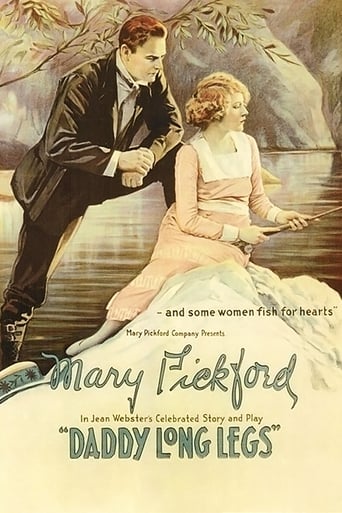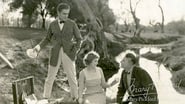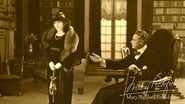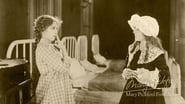Cineanalyst
At one point in the film, "Daddy-Long-Legs", Judy Abbott writes the story of her life at the orphanage, which we had previously seen. Mary Pickford's increased control over her vehicles in return increased the power of screenwriters. Frances Marion had launched Pickford to stardom by adapting "The Poor Little Rich Girl" and other works--establishing Pickford's typical role as a child--but Marion is absent on this one. Yet, although "Daddy-Long-Legs", is authored by others, it doesn't stray from Marion's formula during the first part: a sympathetic predicament for the child, offset by comedic set pieces. It entertains while holding the audience's emotions. This film is full of intertitles, as well. Ferdinand Earle's "art titles" occur more often during the introductory scenes than do moving pictures (it seems fades do, too). The entire story is largely told this way, and it indicates the important role of the screenwriter.There's no surprise here. If you're familiar with Pickford's films, you know what you're going to get, and "Daddy-Long-Legs" gives you just that. There is the college years afterward, but that's in the same spirit. The transformation from adolescent to college student is convincing enough. The entire movie is episodic. The pacing is appropriately brisk. And, the girl with the golden curls does her usual thing.Hollywood movies were looking great by this time, and "Daddy-Long-Legs" reflects that. There are plenty of iris shots, including a masking wipe that acts as a curtain after a performance of "Romeo and Juliet". The film is amply lit and tinted. There are silhouettes and dark photography aided by blue tinting--so we may still see Mary. And, the camera gets close. The film shows the common look and technique of 1919 Hollywood pictures. On the other hand, not much has changed since Maurice Tourneur directed Pickford in "The Poor Little Rich Girl" two years afore. They still use large sets to make her appear even shorter while portraying an adolescent. There was much gloss to it, as well. Most of all, it's still passable, light entertainment.
drednm
Another terrific Mary Pickford performance and film. Daddy-Long-Legs is a familiar story, but the Pickford version accentuates the comedy and leaves the sappy romance to the horrid 50s version with Astaire and Caron. Sweet and innocent, this film has several memorable comic moments, including Mary getting drunk with a fellow orphan (Wesley Barry?) and leaving the jug for a dog. Very funny. A little tipsy, Mary also slides down banisters and accidentally knocks "Stink Weed" down a well. Oops! This film is a little unusual for a Pickford picture since it allows Mary to grow up. She gets to go to college and be wooed by her roommate's uncle (Mahlon Hamilton). She's also pursued by Jimmie (Marshall Neilan, who also directed the film). Milla Davenport is the orphanage director and Fay Lemport is the nasty Angelina.Nice comedic touches throughout to keep it all light and entertaining. The version I saw was clean, had beautiful title cards, and good (new) score my Maria Newman. All very impressive for a 1919 film. This film seems miles away from Pickford's 1917 Pride of the Clan, but she had been in over 200 films by the time she made this! Pickford was one of the greats, a true giant in Hollywood, and it's too bad she's so forgotten now. I've never seen a Pickford film I didn't like.
claudecat
Mary Pickford gives her usual delightful performance in "Daddy Long Legs", but the screenplay for this movie drove me crazy. The storyline jumps around and is misleading. For example, Mary's character Judy is at first shown to be a tomboy who speaks the sort of Huck Finn dialect that silent-film intertitle writers found so amusing, but suddenly we're told that she's a brilliant scholar. The impression I had up to then was that the orphanage kids weren't exactly being given a stellar education. The supporting characterizations are also inconsistent. The orphanage mistress is mostly murderously abusive, but then is shown desperately trying to help Judy catch a train to a new school. Why does she suddenly care? Judy's young suitor is portrayed alternately as an oafish fool and a charming lad, 'til we don't know what we're supposed to think of him. I'm not saying movie characters should be one-note--the heartless rich girl in the story is so unbelievably mean that she's dull--but the extreme switches indicate that the screenplay wasn't well-thought-out. There are loads of loose ends: what was the deal with the broken tail-light? What happened to the $1000 check? Why was Mary too ashamed to tell a certain story about herself, but not too ashamed to write a book about it? AND DID THAT GIRL EVER GET OUT OF THE WELL? I also was kind of creeped out by the Jarvis Pendleton character--he was too controlling. There are good things in the film besides Mary: the photography and tinting are beautiful (though the untinted whites of Mary's eyes are a little distracting), I liked the score, and the subject of the orphanage was an important one in its day. (I just today heard a radio documentary that discussed orphanages of that period, and they were much worse than the one in the film, which I had wrongly assumed was exaggerated.) To the film's credit, Judy works hard to become independent, but that aspect of the story isn't fully explored.All in all, worth it for serious Mary fans, but for everyone else, I'd recommend "My Best Girl" over this one any day.
Snow Leopard
A wonderful and multi-faceted performance by Mary Pickford turns a pleasant but somewhat routine story into a fine film that is very enjoyable to watch. The story gives her a chance to use a lot of different talents, and whenever she is on-screen, which is most of the time, there is something worth seeing.Pickford is equally charming (it seems impossible to write about a Pickford film without using that word) and equally believable as a young orphan and as a college girl. And she is equally good at creating laughs, expressing feelings, and evoking sympathy - often all at the same time, especially in the orphanage scenes, which have some of this film's best material. There is some excellent comedy that keeps the story from becoming overly cute or sentimental, and she makes the most of all of it.They put some real work into the title cards for this one, filling them with some good art work and also using them at times for some well-chosen commentary. A couple of the other cast members are pretty good, too, although it is definitely Pickford that makes this so worthwhile.This is an engaging little gem from the silent era, and a great example of what it was that made "America's Sweetheart" so popular.






